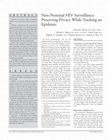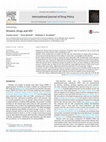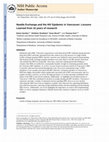Papers by Steffanie Strathdee

International Journal of STD & AIDS, 2013
We examined the relationship between venue stability and consistent condom use (CCU) among female... more We examined the relationship between venue stability and consistent condom use (CCU) among female sex workers who inject drugs (FSW-IDUs; n = 584) and were enrolled in a behavioural intervention in two Mexico-USA border cities. Using a generalized estimating equation approach stratified by client type and city, we found venue stability affected CCU. In Tijuana, operating primarily indoors was significantly associated with a four-fold increase in the odds of CCU among regular clients (odds ratio [OR]: 3.77, 95% confidence interval [CI]: 1.44, 9.89), and a seven-fold increase among casual clients (OR: 7.18, 95% CI: 2.32, 22.21), relative to FSW-IDUs spending equal time between indoor and outdoor sex work venues. In Ciudad Juarez, the trajectory of CCU increased over time and was highest among those operating primarily indoors. Results from this analysis highlight the importance of considering local mobility, including venue type and venue stability, as these characteristics jointly influence HIV risk behaviours.
Journal of Psychoactive Drugs, 2005
Injection drug use is a growing but understudied problem in Tijuana, a city situated on the north... more Injection drug use is a growing but understudied problem in Tijuana, a city situated on the northwestern Mexico-U.S border. The authors studied factors associated with receptive needle sharing in an effort to inform prevention activities. In 2003, street-recruited injection drug users (IDUs) in Tijuana underwent interviews on injection risk behaviors and rapid HIV antibody tests. Logistic regression was used to

American Journal of Epidemiology
Some studies have indicated that needle exchange programs (NEPs) can be effective in reducing dru... more Some studies have indicated that needle exchange programs (NEPs) can be effective in reducing drug-related risks for human immunodeficiency virus (HIV) seroconversion; however, others have reported higher HIV incidence rates among NEP attendees. Since many studies rely on self-reports of NEP attendance, the authors investigated the extent to which differential misreporting of NEP attendance could bias risk estimates. Over a 3-year period from 1994 to 1997, self-reports of NEP attendance from participants in a prospective study in Baltimore, Maryland, were compared with NEP records. Of 1,315 participants, 459 (35%) had registered with the Baltimore NEP. There was 86.7% concordance between self-reported and actual NEP use; 11.0% reported NEP attendance but did not attend (overreported), and 2.2% reported not attending NEP but did attend (underreported). In multivariate analyses using generalized estimating equations, persons who overreported NEP attendance were more likely to have inj...

Canadian journal of public health. Revue canadienne de santé publique
To enhance HIV surveillance within a non-nominal provincial testing system. Confirmatory HIV test... more To enhance HIV surveillance within a non-nominal provincial testing system. Confirmatory HIV tests from a provincial laboratory were analyzed during 1995 and 1996. Enhancements included elimination of repeat positive tests for the same individual using automated matching of non-nominal identifiers and nurse call-back of health care providers, completion of missing information through call-back and connection of providers with resources for patient care. Forty-seven percent of 2,683 reactive HIV tests were identified as duplicates for the same individual, meaning that 1,401 people tested positive for the first time. From laboratory test data to enhanced unduplicated data after call-back, the proportion of tests for which risk and ethnic information was unknown dropped from 37% to 11% and from 64% to 18% respectively (p < 0.0001). Enhanced non-nominal surveillance for HIV is a practical means of marrying the needs of public health for epidemiological information and the rights of p...

Journal of the International AIDS Society, 2015
Peace and stability in Eastern Europe is now at a crossroads with the rapidly deteriorating forei... more Peace and stability in Eastern Europe is now at a crossroads with the rapidly deteriorating foreign policy crisis continuing to unfold in the Ukraine. However, largely overlooked in the context of other foreign policy and diplomatic priorities are the serious public health consequences for the region following the annexation of Crimea and the subsequent decision to ban opioid substitution therapy in the disputed territory. On 1 May 2014, the Republic of Crimea officially announced it would end access to opioid substitution therapy, an essential harm reduction tool recognized by international organizations and virtually all other European countries. The policy development marks a critical reversal in the region's fight against its growing HIV epidemic and also threatens years of public health gains aimed at providing evidence-based and integrated treatment approaches to combat drug dependence and HIV. Beyond these risks, the Ukrainian conflict could also negatively impact control...

International journal of gynaecology and obstetrics: the official organ of the International Federation of Gynaecology and Obstetrics, 2015
To explore experiences during childhood and adolescence that influenced reproductive and sexual h... more To explore experiences during childhood and adolescence that influenced reproductive and sexual health among women who had entered the sex industry in adolescence. A qualitative study was conducted using information provided by 25 female sex workers (FSWs) from Tijuana, Mexico, who reported entering the sex industry when younger than 18 years. In-depth, semi-structured interviews were conducted with all participants between January 31, 2011, and July 8, 2011. Four interrelated themes that shaped health experiences-early sexual abuse, early illicit drug use, ongoing violence, and limited access to reproductive and sexual health care-were identified. Participants reporting these experiences were at risk of unintended teenaged pregnancy, spontaneous abortion or stillbirth, and untreated sexually transmitted infections. Programs and policies that address social, structural, and individual vulnerabilities during adolescence and adulthood are required to promote reproductive and sexual he...
Clinical infectious diseases : an official publication of the Infectious Diseases Society of America, 2014
AIDS patient care and STDs, 2004
Background-Drug market policing has been associated with various harms among injection drug users... more Background-Drug market policing has been associated with various harms among injection drug users (IDU). However, little is known about instances in which drugs and injecting equipment are confiscated from IDU in the absence of a formal arrest.

Drug and Alcohol Dependence, 2015
Injection drug use is increasingly contributing to the HIV epidemic across sub-Saharan Africa. Th... more Injection drug use is increasingly contributing to the HIV epidemic across sub-Saharan Africa. This paper provides the first descriptive analysis of injection drug use in western Kenya, where HIV prevalence is already highest in the nation at 15.1%. We draw on quantitative data from a study of injection drug use in Kisumu, Kenya. We generated descriptive statistics on socio-demographics, sexual characteristics, and drug-related behaviors. Logistic regression models were adjusted for sex to identify correlates of self-reported HIV positive status. Of 151 participants, mean age was 28.8 years, 84% (n=127) were male, and overall self-reported HIV prevalence reached 19.4%. Women had greater than four times the odds of being HIV positive relative to men (Odds Ratio [OR] 4.5, CI: 1.7, 11.8, p=.003). Controlling for sex, ever experiencing STI symptoms (Adjusted Odds ratio [AOR] 4.6, 95% CI 1.7, 12.0, p=.002) and sharing needles or syringes due to lack of access (AOR 3.6, 95% CI 1.2, 10.5, p=.02) were significantly associated with HIV positive status. Lower education (AOR 2.3, 95% CI 0.9, 5.6, p=.08), trading sex for drugs (AOR 2.8, 95% CI 0.9, 8.8, p=.08), being injected by a peddler (AOR 2.9, 95% CI 1.0, 8.5, p=.05), and injecting heroin (AOR 2.3, 95% CI 1.0, 5.7, p=.06), were marginally associated with HIV. This exploratory study identified patterns of unsafe drug injection and concurrent sexual risk in western Kenya, yet few resources are currently available to address addiction or injection-related harm. Expanded research, surveillance, and gender sensitive programming are needed.

Background: Cigarette smoking and tuberculosis are major global health concerns, and smoking has ... more Background: Cigarette smoking and tuberculosis are major global health concerns, and smoking has been shown to increase the risk for active tuberculosis disease. Cigarette smoking might also increase the risk of Mycobacterium tuberculosis (Mtb) infection, but few studies on this topic have used biochemical assays to determine smoking status. We describe the association between biochemical measures of smoking status and Mtb infection. Methods: A cross-sectional study was conducted among persons who inject drugs in Tijuana, Mexico. NicAlert, a semi-quantitative dipstick-based salivary cotinine assay, was used to measure tobacco smoke exposure. QuantiFERON TB Gold In-tube (QFT) was used to determine Mtb infection. Multivariable log-binomial regression models were used to determine the association between salivary cotinine levels and QFT positivity. Results: Among 234 participants, prevalence of QFT positivity for NicAlert cotinine categories 0 (nonsmoking), 1 (secondhand smoke exposure...

Background: Cigarette smoking and tuberculosis are major global health concerns, and cigarette sm... more Background: Cigarette smoking and tuberculosis are major global health concerns, and cigarette smoking increases the risk of active tuberculosis disease. However, it is unknown whether a causal relationship exists between cigarette smoking and Mycobacterium tuberculosis (Mtb) infection. We analyzed data from a longitudinal cohort study of injection drug users in Tijuana, Mexico to investigate whether cigarette smoking increases the risk of Mtb infection. Methods: Participants were recruited using respondent driven sampling (RDS). Mtb infection status was ascertained using QuantiFERON-TB Gold In-Tube (QFT) assays at baseline and 18 month visits. QFT conversion was defined as interferon-gamma concentrations <0.35 IU/ml in the antigen-stimulated tube minus the nil tube at baseline and ≥ 0.35 IU/ml plus 0.7 IU/ml greater than baseline at 18 months. The number of cigarettes smoked daily was categorized into quartiles. We used multivariable Poisson regression weighted for RDS sampling ...

International journal of STD & AIDS, Jan 22, 2015
Summary Given that syphilis is associated with HIV infection among people who inject drugs (PWID)... more Summary Given that syphilis is associated with HIV infection among people who inject drugs (PWID), we examined syphilis incidence among PWID in Tijuana, Mexico. From 2006 to 2007, 940 PWID (142 women and 798 men) were recruited via respondent-driven sampling and followed for 18 months. At semi-annual visits, participants were tested for syphilis and completed surveys, which collected information on socio-demographics, sexual behaviours, substance use and injection behaviours. Poisson regression was used to estimate syphilis incidence rates (IRs), incidence rate ratios (IRRs) and 95% confidence intervals (CIs). Twenty-one participants acquired syphilis during follow-up (IR = 1.57 per 100 person-years, 95% CI: 1.02-2.41). In a multivariate analysis, syphilis incidence was higher among women (IRR = 3.90, 95% CI: 1.37-11.09), HIV-positive participants (IRR = 4.60, 95% CI: 1.58-13.39) and those who reported ever exchanging sex for drugs, money, or other goods (IRR = 2.74, 95% CI: 0.97-7....

Journal of the International AIDS Society, 2015
Men who have sex with men (MSM) in developing countries such as Mexico have received relatively l... more Men who have sex with men (MSM) in developing countries such as Mexico have received relatively little research attention. In Tijuana, Mexico, a border city experiencing a dynamic HIV epidemic, data on MSM are over a decade old. Our aims were to estimate the prevalence and examine correlates of HIV infection among MSM in this city. We conducted a cross-sectional study of 191 MSM recruited through respondent-driven sampling (RDS) in 2012. Biological males over the age of 18 who resided in Tijuana and reported sex with a male in the past year were included. Participants underwent interviewer-administered surveys and rapid tests for HIV and syphilis with confirmation. A total of 33 MSM tested positive for HIV, yielding an RDS-adjusted estimated 20% prevalence. Of those who tested positive, 89% were previously unaware of their HIV status. An estimated 36% (95% CI: 26.4-46.5) had been tested for HIV in the past year, and 30% (95% CI: 19.0-40.0) were estimated to have ever used methamphet...

Background: Women who use drugs, irrespective of whether these are injected or not, are faced wit... more Background: Women who use drugs, irrespective of whether these are injected or not, are faced with multiple issues which enhance their vulnerability to HIV. Methods: In this commentary, we explore the HIV risks and vulnerabilities of women who use drugs as well as the interventions that have been shown to reduce their susceptibility to HIV infection. Results: Women who inject drugs are among the most vulnerable to HIV through both unsafe injections and unprotected sex. They are also among the most hidden affected populations, as they are more stigmatized than their male counterparts. Many sell sex to finance their own and their partner's drug habit and often their partner exerts a significant amount of control over their sex work, condom use and injection practices. Women who use drugs all over the world face many different barriers to HIV service access including police harassment, judgmental health personnel and a fear of losing their children. Conclusion: In order to enable these women to access life-saving services including needle-syringe and condom programs, opioid substitution therapy and HIV testing and treatment, it is essential to create a conducive environment and provide tailor-made services that are adapted to their specific needs.

During the mid-1990s, Vancouver experienced a well characterized HIV outbreak among injection dru... more During the mid-1990s, Vancouver experienced a well characterized HIV outbreak among injection drug users (IDU) and many questioned how this could occur in the presence of a high volume needle exchange program (NEP). Specific concerns were fuelled by early research demonstrating that frequent needle exchange program attendees were more likely to be HIV positive than those who attended the NEP less frequently. Since then, some have misinterpreted this finding as evidence that NEPs are ineffective or potentially harmful. In light of continuing questions about the Vancouver HIV epidemic, we review 15 years of peer-reviewed research on Vancouver's NEP to describe what has been learned through this work. Our review demonstrates that: 1) NEP attendance is not causally associated with HIV infection, 2) frequent attendees of Vancouver's NEP have higher risk profiles which explain their increased risk of HIV seroconversion, and 3) a number of policy concerns, as well as the high prevalence of cocaine injecting contributed to the failure of the NEP to prevent the outbreak. Additionally, we highlight several improvements to Vancouver's NEP that contributed to declines in syringe sharing and HIV incidence. Vancouver's experience provides a number of important lessons regarding NEP. Keys to success include refocusing the NEP away from an emphasis on public order objectives by separating distribution and collection functions, removing syringe distribution limits and decentralizing and diversifying NEP services. Additionally, our review highlights the importance of context when implementing NEPs, as well as ongoing evaluation to identify factors that constrain or improve access to sterile syringes.

The women, men, and transgender people who sell sex globally have disproportionate risks and burd... more The women, men, and transgender people who sell sex globally have disproportionate risks and burdens of HIV in countries of low, middle, and high income, and in concentrated and generalised epidemic contexts. The greatest HIV burdens continue to be in African female sex workers. Worldwide, sex workers still face reduced access to needed HIV prevention, treatment, and care services. Legal environments, policies, police practices, absence of funding for research and HIV programmes, human rights violations, and stigma and discrimination continue to challenge sex workers' abilities to protect themselves, their families, and their sexual partners from HIV. These realities must change to realise the benefits of advances in HIV prevention and treatment and to achieve global control of the HIV pandemic. Effective combination prevention and treatment approaches are feasible, can be tailored for cultural competence, can be cost-saving, and can help to address the unmet needs of sex workers and their communities in ways that uphold their human rights. To address HIV in sex workers will need sustained community engagement and empowerment, continued research, political will, structural and policy reform, and innovative programmes. But such actions can and must be achieved for sex worker communities everywhere.











Uploads
Papers by Steffanie Strathdee